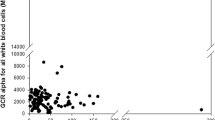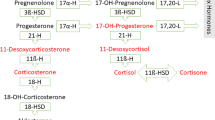Abstract.
Objective: To study the time course of corticosteroid binding-globulin (CBG) level and the free cortisol index (FCI) in comparison with total cortisol and ACTH concentrations during acute and prolonged critical illness. Design: Prospective observational clinical study. Setting: Twenty-bed medical/surgical intensive care unit. Patients and participants: Thirty patients with septic shock, eight patients with multitrauma, and forty healthy control subjects. Measurements and results: During 14 days or until discharge/death, we serially measured serum concentrations of CBG, cortisol, TNF-α, IL-6, plasma ACTH immunoreactivity, and the FCI (=cortisol/CBG × 100). We also recorded haemodynamic parameters, APACHE II, ISS, SOFA scores, shock duration, inotrope use, and ICU mortality. In both groups we found markedly decreased CBG levels in the early phase (septic shock: 17.5±5.9, and trauma: 16.1±2.3 mg/l) in comparison with controls (37.3±5.3 mg/l). The FCI was high in this early phase (septic shock: 7.2±2.7; trauma: 6.5±1.3; controls: 1.25±0.76). During follow-up, CBG levels significantly increased, reaching normal levels from day 7 on. The FCI showed an opposite biphasic pattern, with near-normalising FCI values during the second phase. Regression analysis showed a negative correlation between CBG and IL-6 levels (r s=–0.63; P<0.05), but no relation between CBG concentrations and disease severity, shock duration or death was found. Conclusions: We found extremely low CBG levels in early stage septic shock and multitrauma. These dramatic changes are reflected in a concomitant higher FCI, indicating a higher free cortisol level. A second phase displays increasing and normalising CBG levels, independent from clinical parameters. We believe that CBG plays an active role in the glucocorticoid response to severe stress and in the regulation of cortisol availability to target tissues.
Similar content being viewed by others
Author information
Authors and Affiliations
Additional information
Final revision received: 27 July 2001
Electronic Publication
Rights and permissions
About this article
Cite this article
Beishuizen, A., Thijs, L.G. & Vermes, I. Patterns of corticosteroid-binding globulin and the free cortisol index during septic shock and multitrauma. Intensive Care Med 27, 1584–1591 (2001). https://doi.org/10.1007/s001340101073
Received:
Accepted:
Published:
Issue Date:
DOI: https://doi.org/10.1007/s001340101073




